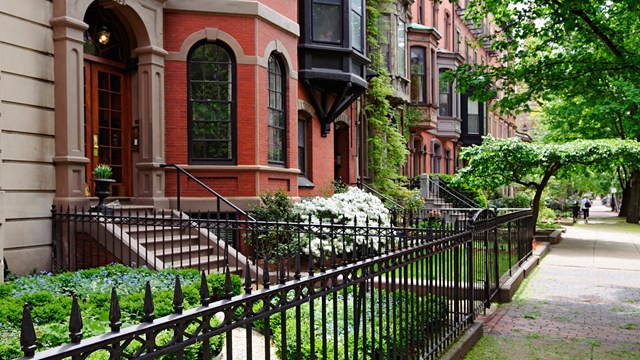For seven years, Mira Calton and her husband, Dr. Jayson Calton, owned a floating home, one of the 165 privately-owned residences on The World, a 644-foot yacht that continuously circumnavigates the globe. Owning a home on the yacht is similar to owning a cooperative—Calton and others purchase a unit by purchasing shares in a corporation. While most cooperative and condominium units around the country are in traditional buildings, there are properties, like The World, that follow a non-traditional style of ownership.
“The amount you pay depends on the square footage of your unit,” says Mira. The World offers studios, one-, two- and three-bedroom suites, where pricing starts in the mid-six-figures and goes to several million dollars. Owners pay for the unit as well as a monthly fee for upkeep and amenities. And, oh boy, the amenities!
“It’s amazing because where can you live where someone asks to bring the grand piano by the pool and do a private show and bring champagne? But you’d better like your spouse, because you’re spending full-time with them,” says Mira.
“It’s the only place in the world where you wake up and your backyard is someplace different—Shanghai, China, Papua, New Guinea, or someplace else,” says Jayson, a nutritional doctor. “It never gets boring.”
The Caltons lived the life that many only dream of. While dating, they both retired at an early 33 years old, eager to travel around the world. “We were married on the ship and used our times in the 135 countries to see how food plays a role in your health,” says Mira, a nutritionist.
The couple took their knowledge from their travels and authored “Rich Food, Poor Food,” sold their unit and temporarily relocated to dry land. “We’ll stay here for 10 years and then go back onto the boat,” says Mira.
To get back onto the boat, they will either purchase, or rent, another unit. To purchase a unit, a prospective buyer must be recommended by two current residents. “To do that, you go onto the boat and mix and mingle with the residents,” says Mira.
While some residents become close to each other in traditional condominiums and cooperatives, Mira says that The World residents really do become family. “If you get sick or need something, everyone calls and sees how you’re doing,” she says.
First launched in 2002, The World creates a truly unique living experience for those fortunate enough to enjoy it. And, of course, while individually owning their units, those residents also collectively own the ship. As owners, the residents have a voice in creating the itinerary—deciding where The World will travel each year—and in planning a program that brings onboard experts in different fields, from diving to wine tasting, to prepare them for the places they’re going to visit. This year’s journey, for example, includes stops in the Canary Islands, Morocco and Ireland.
Art Studios, Too
Most of us, however, tend to have feet more firmly planted, and today, people own a wide variety of condominium-marketed units. There are, in fact, many properties that call themselves ‘condos’ and are treated with the traditional condo business model, but the owners may or may not live there.
In Needham, Massachusetts, you’ll find Gorse Mill Studios, a non-residential community of over 20 artists, specializing in pottery, glass, performing arts, painting and graphic design.
“It’s an artist workspace condo,” says Jay Paget, program director of the Cultural Facilities Fund & ArtistLink, at the Massachusetts Cultural Council. “We support projects that are live-work and work-only. It’s structured like a traditional condominium, where there is an association as well as condo documents. It’s the responsibility of the association to maintain the building.” The role of ArtistLink is to provide technical assistance in the planning for artists and for creative space.
“From our viewpoint, the public good is served, whether it’s creative live space or live-work, for getting creativity produced,” he says. “We designed and crafted a program where individuals or organizations who wanted to supply creative space can do so and we would provide technical assistance to do that. There are some artists who can navigate the legal development of the condo association, but we help artists who don’t have the expertise and who would like to secure a space to be stable and secure the work they do.”
Paget says that, depending on the market in the community, the idea of ownership stability and control for an artist is preferable. “Needham is a suburban community, and these spaces are for those who can’t or don’t want to work at home. There, they have a studio that they own and it’s a sense of community and the exchange of ideas that happen,” he says.
The condominium, he explains, has the advantage of offering “a common space that you don’t get when you work individually at home.” The artists create a bond, and tend to participate at shows. “Most would get to know one another; it becomes a community, whether it’s owned or rented.”
The condo-loft concept has grown in popularity—both as a way of life for artists, and as a way for communities to see vacant mills put back into use. One of the newest entries in the “live-work” model in Massachusetts is the Renaissance Lofts building in Marlborough, which promotes living “in Industrial Chic surroundings.” Another condominium property, One Westinghouse Plaza, located in a classic mill building in Boston’s Hyde Park neighborhood, has 62 live-in artist studios. Only artists are allowed to buy the units, and, like any condominium, the building has a governing board, common fees, bylaws, and rules for owners to follow. The lofts range in size from about 800 to 1,200 square feet, and according to a recent check of the building’s website, all but one of the units are sold.
For those who love the outdoors, a “camp-o-minium” can be the ideal vacation spot. Bayberry Cove, in Marmora near Ocean City, New Jersey, and Sun Valley Beach Club and Resort in Stafford Springs, Connecticut, are examples of this popular take-off on the condominium lifestyle.
Typically seasonal, these condominium properties are the antithesis of the live-work artists’ lofts—they’re designed not for work, but for play, featuring amenities like swimming pools or ponds, picnic areas, tennis courts and playgrounds. Condo owners at these properties aren’t buying units within a building; they buy the sites on which they can park their home-away-from-home for days, weeks or months at a time as the spirit moves them.
Stow It
Think condos are just for people? Think again. Greg Thompson was in the real estate industry for 15 years when he realized that his business was overtaking his home. “I could never park my car in my garage,” he says. “I had a small business and accumulated a lot of stuff, so I wanted a small shop close to my house that had a bathroom, but didn’t cost me a lot. I bought a two-acre lot in the city, but there were restrictions on me and I was stuck again. Plus, I still couldn’t park my car in the garage.”
Frustrated, Thompson purchased another few acres, built a storage unit ‘condo’ and had an open house. What he developed was a residential-style, office-warehouse product, commercially-zoned, that utilizes the duplex and condominium concept. A unit is approximately 25-ft. wide by 50-ft. deep with 14-ft. ceilings, a 12-ft. by 13-ft. overhead door and provides enough room and height to accommodate most any vehicle. All units in his StorageShopUSA properties have heat, lights, 100amp service, phone, cable, bathroom plumbing, drywall and painted walls.
“Saturday I was cleaning it, getting ready for the open house and a guy gets out of his car, points to the building and says, ‘I want that one,’ and then I couldn’t build them fast enough,” says Thompson, who now has 16 locations across Wisconsin.
Unit owners purchase the unit and, just like with traditional condominium properties, there are condo documents, a condo association and a condo board. “It doesn’t matter if it’s commercial or residential; it’s a form of ownership,” says Thompson. “They pay a fee every month to maintain the property, including shoveling and lawn care. They are also self-managed to keep the costs down.”
Thompson says that half of the owners purchase them for business. “The other half are hobbyists who need a personal extension of their home,” he says. “Someone needs to move the shop out of the garage so he can park his car or someone wants a man cave of their own.”
Park It Here
Got a boat, but no room to keep it? You’re in luck: Boat storage has gone condo, too. The Barefoot Boat Club in Bonita Springs, Florida, is among the condos meeting the needs of watercraft owners. Along with 90 indoor boat storage “rackominiums,” and 18 wet slips that can be purchased or rented, the condo-styled property boasts amenities like valet boat service, detailing and waxing, and motor repair.
Oh, and don’t forget the extras—like the clubhouse that’s available for meetings, parties or weddings; the swimming pool; and the tiki bar.
While long familiar to Florida residents, boat-o-miniums have gained popularity around the country, too. In recent years, they’ve cropped up in Portland, Oregon, Grand Haven, Michigan—and even Arizona, where a 300-unit boat storage facility is billed as being “conveniently located minutes from the Colorado River with Lake Mead National Recreation Area and Katherine Landing to the north and Park Moabi and Lake Havasu to the south.”
And owners don’t just view their boat-centered condos as out-of-sight, out-of-mind shells. In promoting the concept to the self-storage industry a few years ago, Caesar Wright, president of Mako Steel Inc., which designs such facilities, noted that owners take pride in their boat storage units, just like owners of residential condos. “They definitely see their units as extensions of their homes,” going so far as to paint interiors and even install insulation or windows, he said. Similar condos are available across the nation for the storage of recreational vehicles (RVs), antique autos or other cherished possessions.
From offices to boat slips, artist lofts, and so much more—the benefit of owning, rather than renting, has reached beyond the concept of “home, sweet home” across the nation today.
Lisa Iannucci is a freelance writer and a frequent contributor to New England Condominium. Associate Editor Pat Gale also contributed to this article.






Leave a Comment